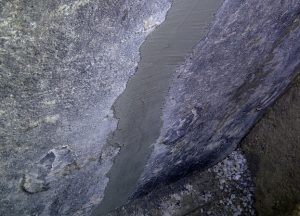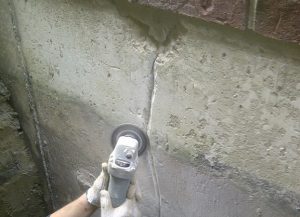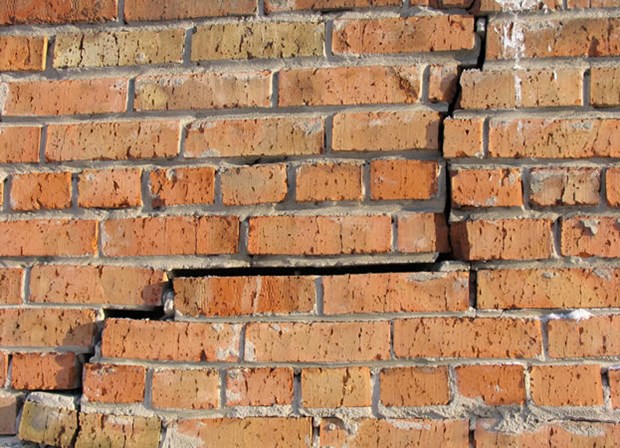You’ve been diligent about following all the recommendations for preventing basement flooding. You take care of cleaning out your gutters and maintaining the perfect grade away from the foundation. You’ve got a sump pump installed and even added a battery back-up in case of a power outage. Then, you do your annual inspection and find it…the dreaded basement wall crack. Before you panic and start to worry, read about the different reasons cracks occur, what to do to repair them and what else you should watch out for.
Causes of Foundation Damage

A wide number of factors contribute to foundation damage. No matter how proactive you are with waterproofing, no house is completely safe from flooding danger. Common causes include: Overly wet or dry soil, frequent temperature changes, loose soil, poor construction, bad drainage and earthquakes. There are many symptoms of damage that may indicate minor or serious problems.
Foundation Cracks & Other Symptoms
There are three basic types of foundation cracks you’ll notice: Shrinkage – generally found with poured concrete; horizontal – caused by soil or water pressure; and settlement – this occurs in most homes but the size and location of the cracks will determine how much has occurred. A little unevenness caused by settling is normal, but you should watch for these more dramatic changes inside:
- Drywall cracks in main house walls and ceilings
- Misaligned doors and windows
- Ceramic tile and brickwork cracks
- Sloping floors
- Bowing walls
There are other structural components supporting your home. Posts, concrete supports or piers are placed in specific locations in your basement or crawl space to provide load-bearing support. They should be straight and fit tightly underneath the rafter beams. The posts shouldn’t lean or move and the base should be firmed affixed to a concrete pier.

An outside check will help you determine if there are major concerns brewing. Look down the foundation wall from each corner to check for leaning or bowing. Problems like this could mean the foundation has shifted or that there is pressure from expanding and contracting soil.
Concrete deterioration is another problem you may encounter. If the exterior walls appear to be chipping or flaking, probing with a screwdriver may help you find a more serious issue. You shouldn’t be able to damage it, but if pieces chip or break off, you’ll need to contact a professional.
Monitoring A Potentially Dangerous Problem

Cracks can form in both poured concrete and block foundations. As concrete and mortar between blocks dry, it shrinks. Cracks often originate in 90-degree corners, so check those places carefully. Stepped cracks along block foundations or brick walls may be caused by upheaval. The best way to stave off major repair work is to monitor the crack width. Mark a spot along the crack and accurately measure the width with a ruler. Check back often to re-measure. If the crack begins to get wider at one end, it may be a sign of big trouble. Anything ½ inch or wider should be evaluated by an engineer for safety.
A horizontal crack that appears in the bed joint of a brick or concrete block wall should not be ignored. This signals a major breakdown. Pressure of the soil behind the wall has pushed it to a point of bending or breaking. Corroded wall ties, an inadequate number of ties or wind pressure can also cause the wall to bend. This is a serious problem and must be addressed quickly to avoid structural collapse.
Just like the horizontal crack is bad news, so is a vertical crack. Cracks that present wider at the top usually mean the foundation is dropping or the center of the foundation is heaving. For cracks that are wider at the bottom, the foundation is likely heaving and the center is dropping. Either way calls for a structural engineer visit to evaluate your situation.
Not All Cracks Require Attention

Luckily, there are some cracks that are more aesthetic in nature and really won’t hurt anything if left untreated.
Angular cracks can occur in the top 12-16 inches of a brick wall that is laid directly on a concrete foundation. They are caused by brick expansion during summer months and the outer foundation corner being pushed with it. No need to repair them, as they’ll likely occur every year as the temperatures heat up.
Cracks in the upper levels of your home may appear above interior doors, windows and archways. While they may be a sign of settlement, most times, they are simple relief joints. As temperatures outside change, so will the size of these cracks. Running a humidifier in the winter and dehumidifier in the summer will help control these harmless eyesores.
Basement floor hairline cracks are also common, and unless they widen to a 1/2 inch or more, should only affect the appearance. The crack usually starts at a 90-degree offset corner and radiates into the room. Wait about a year for it to finish growing before filling it in with urethane caulk or hydraulic cement.
Conclusion
By taking a proactive approach to changes in your home’s structure, you may be able to avoid major renovation work.
Article courtesy or improvenet.com

